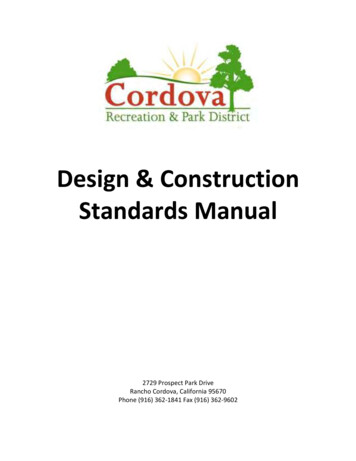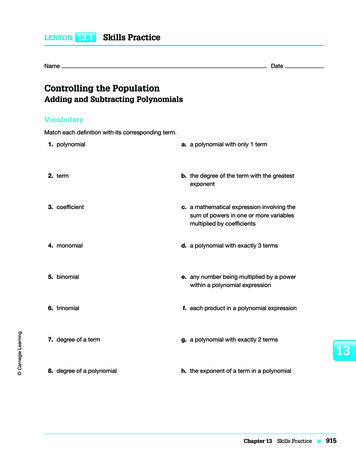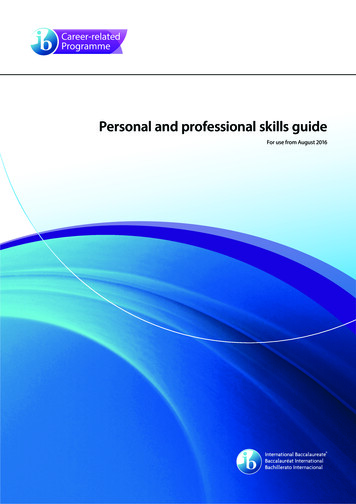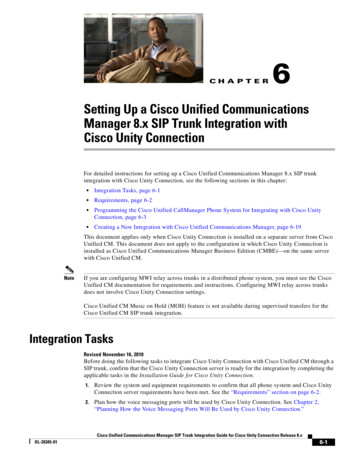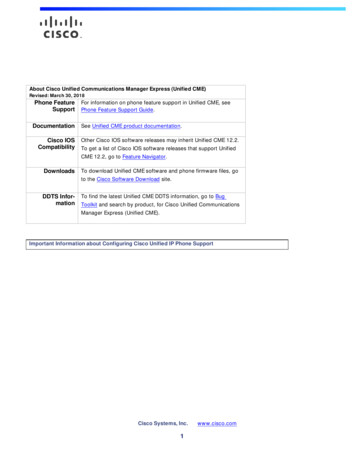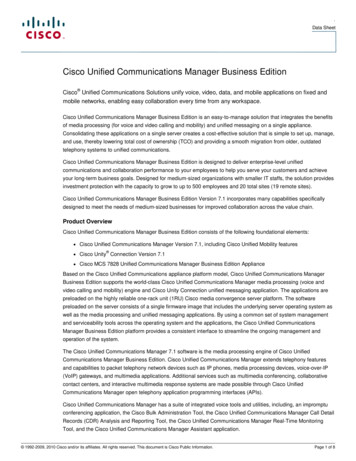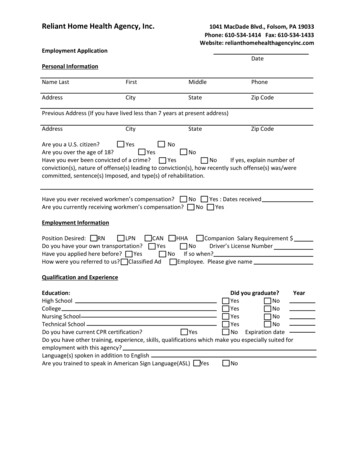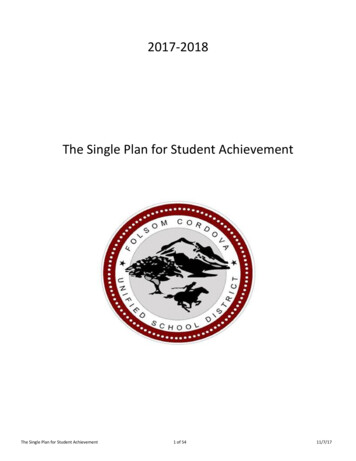
Transcription
2017-2018The Single Plan for Student AchievementThe Single Plan for Student Achievement1 of 5411/7/17
Folsom Hills ElementarySchool:Folsom Hills ElementaryCDS Code:34673306109755District:Folsom Cordova Unified School DistrictPrincipal:Shawn Michael LundbergRevision Date:September 27, 2017The Single Plan for Student Achievement (SPSA) is a plan of actions to raise the academic performance of all students.California Education Code sections 41507, 41572, and 64001 and the federal Elementary and Secondary Education Act(ESEA) require each school to consolidate all school plans for programs funded through the ConApp and ESEA ProgramImprovement into the SPSA.For additional information on school programs and how you may become involved locally, please contact the followingperson:Contact Person:Shawn LundbergPosition:PrincipalPhone Number:916.294.9135Address:106 Manseau DriveFolsom, CA 95630slundber@fcusd.orgE-mail Address:The District Governing Board approved this revision of the SPSA on November 16, 2017.The Single Plan for Student Achievement2 of 5411/7/17
Table of ContentsSchool Vision and Mission .5School and Community Profile .5Comprehensive Needs Assessment Components .5Data Analysis .5Surveys .5Classroom Observations.6Analysis of Current Instructional Program .6Description of Barriers and Related School Goals .10Evaluation of Effectiveness Summary .11School and Student Performance Data .14CAASPP Results (All Students) .14CELDT (Annual Assessment) Results.18CELDT (All Assessment) Results.192016-17 "At-Risk" and Long-Term English Learners (LTEL) .20District Assessment Form - English Language Arts .22District Assessment Form – Mathematics .23Summary of Additional Assessment Data .24Survey of School Effectiveness Summary .25Planned Improvements in Student Performance .26English/Language Arts .26English Language Development .30Mathematics.33Disproportionality .36World Language .39Science.41Counseling/SEL .43Physical Education and Health .45Summary of Expenditures in this Plan.47Total Allocations and Expenditures by Funding Source .47Total Expenditures by Object Type.48Total Expenditures by Object Type and Funding Source .49Total Expenditures by Goal .50Annual Notice of Uniform Complaint Procedures & Non-Discrimination/Sexual Harassment Policies .51School Site Council Membership .52The Single Plan for Student Achievement3 of 5411/7/17
English Learner Advisory Committee (ELAC) Membership.53Recommendations and Assurances.54The Single Plan for Student Achievement4 of 5411/7/17
School Vision and MissionFolsom Hills Elementary’s Vision and Mission StatementsFolsom Hills Elementary School, via it's internal PLC and MTSS groupings, has created a vision for all students to succeed at theirhighest academic, social, and emotional potential.Our school wide academic program is based on clearly defined standards and high expectations for all students academically,emotionally, and behaviorally. Staff collaborate using up to date curriculum, professional development, and interventions to supportstudents at risk in order to close the achievement gap and create an environment for student success. Professional LearningCommunities and their interconnected communication and collaborative strategies, have redefined our approach to ensuring thisvision is implemented with fidelity.FHE is a safe, healthy learning environment based on a belief that students learn to be accountable for their behavior to assure asuccessful school experience. Parents and public are encouraged to be involved with the school program through our PTA, SchoolSite Council, and classroom volunteer program (Kiln, FAME, buDDies, PC Pals, etc.)The district-adopted academic curriculum provides for both basic skills and enrichment in the regular classrooms. The staff andparents of Folsom Hills students have worked hard to create an academically and socially rich elementary school setting in which ourstudents strive for social and academic success.School and Community ProfileFolsom Hills is an elementary school in Folsom, California, enrolling Pre-K through 5th grade students and families. For the 20172018 school year, FHE serves approximately 600 students (CalPads 2016 was 592).If an individual were to look into any classroom at Folsom Hills, they would find parent volunteers, along with teachers,assisting students with both academic and social goals and benchmarks. One would also see specially trained parent KILN(clay) docents, FAME (art) docents, science docents, and Intel VMG volunteers working with the students. PC Pals are onsite severaltimes each trimester, and community programs - from the police and fire departments, to local businesses - are a positive andengaged presence on campus.Parent involvement is the focus of our PTA activities. We are pleased to say that our PTA membership is one of thehighest in the Third District Council. PTA is improving the quality of instruction by providing funds for field trips, equipmentfor student productions, technology, books, and other instructional activities, as well as paying for our Project Lead the Way (PLTW)curriculum, and supporting our Spanish Magnet staff and students.For additional information about organized opportunities for parent involvement at Folsom Hills Elementary School, pleasecontact Tracy Kraakevik - School Clerk at 916.294.9135 or tkraakevik@fcusd.orgContact Information:Parents or community members who wish to participate in leadership teams, school committees, school activities, orbecome a volunteer may contact Vicky Cackler - Administrative Assistant at vcackler@fcusd.org, Tracy Krakevik - School Clerkat tkraakevik@fcusd.org or Shawn Michael Lundberg - Principal at slundber@fcusd.org. Folsom Hills encourages parent andcommunity involvement and welcomes the comments of all parties.Comprehensive Needs Assessment ComponentsData AnalysisPlease refer to the School and Student Performance Data section where an analysis is provided.SurveysThe Single Plan for Student Achievement5 of 5411/7/17
This section provides a description of surveys (i.e., Student, Parent, Teacher) used during the school-year, and a summary of resultsfrom the survey(s).Folsom Hills students, staff and families are encouraged to provide input and feedback about school improvement throughcompleting the FCUSD School Effectiveness Survey, PTA enrichment surveys, small business and volunteer surveys, and the federallyfunded Healthy Kids/Healthy Families surveys. With an additional number of second language students enrolling at FHE, we havealso opted to provide ELAC effectiveness surveys for 2017-2018.Results of these surveys are analyzed to determine areas of strength, as well as areas for on-going development. Surveysadministered throughout the 2016-2017 school year indicate that all elements in the School Effectiveness Survey fall within thedistrict and equivalent-school norms. The area of Parent Involvement and School-To-Home Communication were viewed as anexceptional strengths. Other areas and sub elements identified for focus included MTSS for students in TK and K programs, andcontinuing the refinement of our Professional Learning Communities; the growth and implementation of the FHE PLCs is of primaryfocus.Classroom ObservationsThis section provides a description of types and frequency of classroom observations conducted during the school-year and asummary of findings.The school principal regularly visits classrooms, observing student learning and teaching, and does weekly walk-throughs of allprograms (Autism and language preschools, core classrooms, FLES classrooms, PLTW classrooms, as well as MTSS groupings).Formal evaluations for probationary teachers take place twice in the Fall and twice in the Spring. Tenured teacher formal evaluationis once in the Fall and once in the Spring. Teachers being evaluated are also subject to informal evaluations throughout the year.Both formal and informal feedback target the six California Standards for the Teaching Profession (CSTPs). A review of all data fromthe 2016-2017 school year indicate that classroom teachers at Folsom Hills implement practices and strategies aligned with theseprofessional standards and expectations, and will continue to do so throughout the 2017-2018 school year.Analysis of Current Instructional ProgramThe following statements are derived from the Elementary and Secondary Education Act (ESEA) of 1965 and Essential ProgramComponents (EPCs). In conjunction with the needs assessments, these categories may be used to discuss and develop criticalfindings that characterize current instructional practice for numerically significant subgroups as well as individual students who are: Not meeting performance goalsMeeting performance goalsExceeding performance goalsDiscussion of each of these statements should result in succinct and focused findings based on verifiable facts. Avoid vague orgeneral descriptions. Each successive school plan should examine the status of these findings and note progress made. Specialconsideration should be given to any practices, policies, or procedures found to be noncompliant through ongoing monitoring ofcategorical programs.Standards, Assessment, and Accountability1.Use of state and local assessments to modify instruction and improve student achievement (ESEA)To plan instruction and best meet all student needs, PLC groupings and ECBN meetings at Folsom Hills analyze the results frommultiple assessments including the CAASPP, the CELDT and the LEA assessments (DPA's, math benchmarks, Oral ReadingPassages, Early Literacy Assessment, Kindergarten Readiness Assessment, iReady) to plan and modify instruction in order tocontinually improve student achievement. Data analysis and planning to improve instruction is the primary goal of our PLC andECBN meetings.FHE also collaborates 3 times per year with the district lead teachers in ELA and mathematics to discuss our responses tointervention and strategies to close the achievement gap.The Single Plan for Student Achievement6 of 5411/7/17
2.Use of data to monitor student progress on curriculum-embedded assessments and modify instruction (EPC)Teachers will conduct curriculum assessments regularly, to provide support and design and implement interventions to supportstudents' learning. Folsom Hills also uses MTSS and grade level PLC meetings each month to assess needs, and modifyinstruction, offer professional development, and create interventions to support learning. Each meeting is focused on dataanalysis and implementation of said intervention with fidelity.Staffing and Professional Development3.Status of meeting requirements for highly qualified staff (ESEA)All teachers at Folsom Hills meet the requirements for highly qualified staff, per the stated expectations and requirements of theFCUSD Human Resources Department.4.Sufficiency of credentialed teachers and teacher professional development (e.g., access to instructional materials training onSBE-adopted instructional materials) (EPC)All staff participate in on-going professional development provided by the county, district, and site level. Professionaldevelopment is incorporated through FCUSD professional development days, district facilitated instructional focus meetings, siteteacher release time, site professional development provided by site-based coaches, and designated professional developmentvia PLC focus meetings.5.Alignment of staff development to content standards, assessed student performance, and professional needs (ESEA)All professional development is based on social/emotional needs and quality academic instruction; academics address CCSS,with a focus on maximizing student engagement. Integration of speaking, listening, reading, and writing across the curriculum isa primary focus.Based on review and input of the data available, the following areas are being targeted:*Professional Learning Communities (PLCs) with a focus on teacher-driven data analysis to assess and adapt to student progresslevels*FLES/Spanish Magnet*PLTW/STEM*SMART Goal setting*PBIS*MTSS*Reading Fluency, Comprehension, Vocabulary Development, and Writing in grades 1-5*EIBT programs at the preschool level6.Ongoing instructional assistance and support for teachers (e.g., use of content experts and instructional coaches) (EPC)District lead teachers provide on-going support to teachers. The professional development Cadre facilitates Instructional FocusMeetings to provide teachers time for collaboration and Professional Development days have been added to the instructionalcalendar.Staff members collaborate and analyze student data on a regular basis during site level PLCs, as well as on teacher release daysThe Single Plan for Student Achievement7 of 5411/7/17
for professional development.7.Teacher collaboration by grade level (kindergarten through grade eight [K–8]) and department (grades nine through twelve)(EPC)Grade level collaborations, via PLCs, occur twice per month and for all grades. These collaborations center around curriculumdelivery, shared lesson planning, and needs analysis. Informal teacher collaboration occurs regularly before school, after schooland during teacher prep time.Coupled with formal and informal collaborations, Folsom Hills also conducts ECBN (Every Student By Name) meetings 3 timesper year, wherein Intervention and SAI teachers collaborate to implement IEP and SST goals.Teaching and Learning8.Alignment of curriculum, instruction, and materials to content and performance standards (ESEA)All TK-5 teachers at Folsom Hills are using the Common Core State Standards (CCSS) as the basis of their instruction. Teachersare focusing on incorporating collaborative conversations, utilizing the FCUSD Common Core ELA and mathematics curriculumalignment and instruction expectations.Preschool teachers utilize the nationally normed EIBT standards for autism.9.Adherence to recommended instructional minutes for reading/language arts and mathematics (K–8) (EPC)Folsom Hill's Elementary's daily/weekly schedule provides students with the required number of instructional minutes per day.Specific ELA and Mathematics minutes (as a minimum) are as follows:*TK/K: 60 minutes of Mathematics/80 minutes of ELA*Grades 1 and 2: 90 minutes of Mathematics/150 minutes of ELA*Grades 3, 4, and 5: 90 minutes of Mathematics/120 minutes of ELAIt should be noted that these minutes include early/late friend time, MTSS groupings, and whole-class instruction.10. Lesson pacing schedule (K–8) and master schedule flexibility for sufficient numbers of intervention courses (EPC)District pacing windows allow teachers to monitor their instructional progress. MTSS groupings are realigned every 4-6 weeks.11. Availability of standards-based instructional materials appropriate to all student groups (ESEA)All students have been provided with instructional materials as mandated by the Williams Act. In addition, student groupsneeding extra support are identified through data collection and provided access to such materials as Lexia, SIPPS, andAccelerated Reader.12. Use of SBE-adopted and standards-aligned instructional materials, including intervention materials, and for high schoolstudents, access to standards-aligned core courses (EPC)Folsom Hills uses district approved SBE-adopted materials.These materials include (but are not limited too):*ELA: Benchmark, SIPPS, FLEX, Step Up to Writing, Handwriting Without Tears, Lexia, Read Naturally, BookFlix, iReady,The Single Plan for Student Achievement8 of 5411/7/17
Accelerated Reader*Mathematics: Envision, iReady*Social/Emotional: Steps to RespectOpportunity and Equal Educational Access13. Services provided by the regular program that enable underperforming students to meet standards (ESEA)All students receive instruction based on their academic level, as assessed by multiple data points/programs. Under performingstudents receive the core instructional program that is delivered by the regular classroom teacher, but are then placed on arotating, needs-based MTSS schedule.The 3-times yearly Every Child By Name Conferences also provide an opportunity to utilize the collaborative model ofinstructional delivery, and place students appropriately based on both academic, and at times, emotional needs.14. Research-based educational practices to raise student achievementThrough the use of PLCs, which offer targeted focus and goal development (and its subsequent implementation), peer evaluatededucational practices are shared at PLC meetings regularly. Teachers and support staff have the opportunity to review anddiscuss research related to student achievement and professional development, especially after meeting with district leadteachers during release time.ELA, Mathematics, STEM, HSS, and EIBT lead teachers review new research-based practices at district-level meetings. Teachersare asked to implement these practices into their classrooms, and they are oftentimes part of the collaborative pre- and postevaluation meetings.Parental Involvement15. Resources available from family, school, district, and community to assist under-achieving students (ESEA)Parents are encouraged to attend Back to School Night and our Open House in the Spring. Our school website and e-alert systemkeeps parents informed about important school information. We also post curriculum support links, provide log-on informationfor Lexia and other math and ELA support programs for use at home. We use SST meetings to help support our most strugglingstudents. Teachers provide on-going communication with parents through progress reports, newsletters, and direct contact.16. Involvement of parents, community representatives, classroom teachers, other school personnel, and students in secondaryschools, in the planning, implementation, and evaluation of ConApp programs (5 California Code of Regulations 3932)Our school's Site Council is consists of five parents who meet regularly with staff to stay informed on school progress and makedecisions about changes. Meeting minutes are public. Folsom Hills will also be holding ELAC meetings for the 2017-2018 schoolyear, based on the number of second language learners enrolled.Funding17. Services provided by categorical funds that enable underperforming students to meet standards (ESEA)Categorical funds pay for the direct support of classroom instruction. FCUSD pays for numerous services for theseunderperforming students. Examples include:*iReadyThe Single Plan for Student Achievement9 of 5411/7/17
*Intervention teachers*SAI staffing*SIPPS*Professional Development*Lead Teachers*Numerous software programs and related technology18. Fiscal support (EPC)Folsom Hills has access to basic district funding. Folsom Hills does not qualify for most other categorical funding. Outside fundingcomes from PTA and school fundraising.Description of Barriers and Related School GoalsThe Folsom Hills’ team prides itself on its connections with our parents and the general community in, and around, the city ofFolsom. While we are very lucky to have the support that we have, there are nonetheless barriers and challenges.The FLES/Spanish Magnet program continues to be challenged by a lack of continuity at the middle school level. While theelementary FLES program is extremely viable and academically focused, with a long waiting list to enter it, we find our studentsdropping out of it once they reach 6th grade. While vertical articulation has worked well between Folsom Hills and the high school,we continue to see students dropping out of the program (and losing skills) once they enter middle school.Folsom Hills is also struggling with a change in clientele. An increasing number of second language learners, lower socioeconomically advantaged families, and an increase in special needs students has brought about a need to rethink our programofferings. As such, we have reached out to outside options and resources to continue to provide enrichment experiences (field trips,art programs, etc ). This has posed a challenge to FHE in terms of funding, as well as bringing about a change in our schedule andacademic offerings.The ability to fit all of the academic and social requirements and expectations into our current time frame is also proving to be asignificant challenge. With the implementation of MTSS, we are finding that early/late friend time is becoming a challenge. Increasedexpectations – all appropriate – but less time to fit them in, is a constant struggle. In order to address this, Folsom Hills will worktoward an integration of science and social studies with English Language Arts and Mathematics.After being a beta test site for CAASPP, and then moving on to the live assessment, we continue to see a need to learn todisaggregate state and local data that is relevant and understandable to parents. While we are gaining in our ability to disaggregatestudent outcomes, Folsom Hills will continue to note student performance trends across subject areas. For the 2017-2018 schoolyear, FHE will focus on essential standards, SMART Goals, and utilizing our PLCs to determine the most effective academic andinstructional strategies, most importantly in the areas of math facts, writing, and reading fluency.The Single Plan for Student Achievement10 of 5411/7/17
Evaluation of Effectiveness SummaryTop 2-3 SPSA Priorities and Major Expenditures Supporting Each PriorityPriority 1:Each student will make at least one year of academicprogress in ELA skills.Expenditures to support priority 1:SIPPS, Intervention Specialist, iReady, other curriculumsupports, as needed.Priority 2:Each student will make at least one year of academicprogress in Mathematics skills.Expenditures to support priority 2:Intervention specialist, other curriculum supports asneeded.Priority 3:Each English Learner will progress toward redesignationwith movement of at least one level in each area ofListening, Speaking, Reading and Writing.Expenditures to support priority 3:BIA support, Intervention Specialist, SIPPS, iReady, othercurriculum supports as needed.-------Strategies Identified in 2016-17 SPSA and Degree of Implementation for Each StrategyDegree of Implementation: FullyImplementedStrategy 1:Every Child By Name meetings: social andemotional evaluations.XStrategy 2:Small groups x 30 minutes x 5 days per weekin grades K-2. Focus on targeted ELA.XStrategy 3:Build MTSS interventions to support thedata gathered at ECBN meetings. Run 6week strategic interventions and monitorprogress.XStrategy 4:SMART GoalsPartiallyImplementedNotImplemented YetModified orEliminatedXStrategy 5:SIPPS training and implementationXStrategy 6:PBISXStrategy 7:GLADXStrategy 8:Professional Learning CommunitiesXStrategy 9:MTSS/Tiered InterventionsXStrategy 10:Formative AssessmentsX--------The Single Plan for Student Achievement11 of 5411/7/17
Barriers to *partially or not implemented strategies and actions taken to mitigate each barrier including adjustmentof SPSA Plan to overcome barrier1. Partially or non-implemented strategy:Formative Assessments.Barrier(s) to strategy:Time for staff to analyze data. iReady implementation.Action(s) taken to mitigate/overcome barrier:Site level release time offered. Lead teacher meetings.2. Partially or non-implemented strategy:GLAD.Barrier(s) to strategy:Not all teachers trained; cost of subs.Action(s) taken to mitigate/overcome barrier:Request more funds from ESC to pay for subs and toencourage attendance.3. Partially or non-implemented strategy:SMART Goals.Barrier(s) to strategy:Effective understanding of concept.Action(s) taken to mitigate/overcome barrier:Extensive review and training. Lead teacher discussions.4. Partially or non-implemented strategy:Barrier(s) to strategy:Action(s) taken to mitigate/overcome barrier:5. Partially or non-implemented strategy:Barrier(s) to strategy:Action(s) taken to mitigate/overcome barrier:6. Partially or non-implemented strategy:Barrier(s) to strategy:Action(s) taken to mitigate/overcome barrier:--------SPSA Strategies that were effective in improving student achievement for the target audience/Data evidenceEffective Strategy:Data Evidence:All teachers participated in Every Student by Namemeetings. These meetings were held 3 times duringthe 2016-2017 school year. 3 sets of meetings arescheduled for 2017-2018.1.ECBN2.Timely administration of assessmentsAll teachers administered these assessments during theadministration window and were taken in accordancewith site and district timelines.3.Tiered intervention programs/MTSSScore increases4.PBISPlanning, implementing, and monitoring three areas forimprovement brought about school-wide review ofpolicies. Increased participation in behavior policies byparents and teachers, and a systemic review of currentpractices.--------SPSA Strategies that were ineffective/minimally effective OR level of effectiveness is undetermined in improvingstudent achievement for the target audience/data evidenceThe Single Plan for Student Achievement12 of 5411/7/17
1.Ineffective strategy:Data Evidence:Use of learning objective or target at the beginning of Consistency is needed. More administrative walk-throughsthe lesson.are needed, as well as continued review by leadteachers.2.Small group instruction (excluding MTSS)Teachers encountered behavioral and special needsbarriers. Emotionally challenged and/or aggressivebehaviors and disruptions disallo
The Single Plan for Student Achievement 2 of 54 11/7/17 Folsom Hills Elementary School: Folsom Hills Elementary CDS Code: 34673306109755 District: Folsom Cordova Unified School District Principal: Shawn Michael Lundberg Revision Date: September 27, 2017 The Single Plan for Student Achievement (SPSA) is a plan of actions to raise the academic performance of all students.
